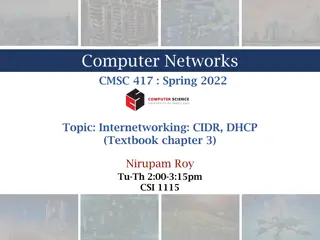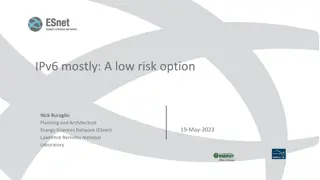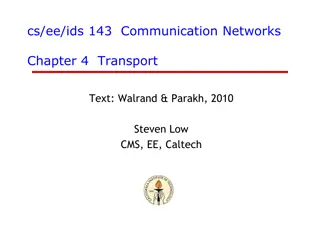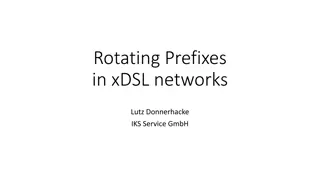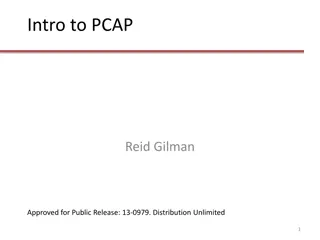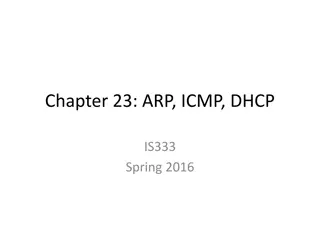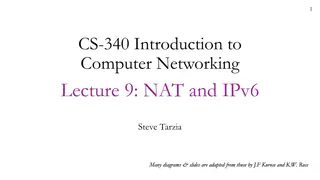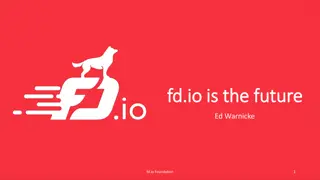Computer Networks CMSC 417 : Spring 2022
Exploring the concepts of Classless Interdomain Routing (CIDR) and Dynamic Host Configuration Protocol (DHCP) in the context of internetworking. CIDR simplifies subnetting by allowing for classless addressing, hiding network hierarchies, and enabling supernetting. Lessons learned from subnetting inc
0 views • 57 slides
Leveraging IPv6-Mostly: A Low-Risk Option for Network Evolution
IPv6-mostly utilizes DHCP Option 108 to enable devices to operate in an IPv6-only mode, enhancing user experience while reducing risk. By leveraging modern technologies like 464XLAT and CLAT, the transition to IPv6 is seamless, with devices automatically adapting to the available network setup witho
0 views • 13 slides
Understanding Communication Networks: Transport and Protocols
Explore the intricacies of communication networks focusing on transport services, protocol stack, UDP, TCP, error control, congestion control, and more. Learn about interworking, routing, DHCP, NAT, connection setup, and error recovery mechanisms. Dive into TCP and UDP headers, handshake processes,
0 views • 46 slides
The Story of How a PC Got Its Name
A PC on a network without a name sends out a DHCP request to get a unique name. The message is duplicated by a switch and reaches the DHCP server, which assigns the PC a new name: 10.0.0.3. The server also provides information about the network setup and offers to forward messages to the outside wor
0 views • 26 slides
Guide to Upgrading IP Phone Software in SCME System
Detailed instructions on moving to PKG in SCME, checking phone versions, upgrading software, and setting up MAC profiles for PNP mode connection with SCME System. Includes steps for both Static IP and DHCP mode upgrades. Essential for SCME administrators and users looking to optimize their IP phone
0 views • 8 slides
Fundamentals of Computer Networks
Explore the essentials of computer networks, covering topics such as DHCP, NAT, IPv6, server operations, and IP address allocation. Understand how DHCP servers control IP address pools and provide network configurations to clients. Learn about address leases for dynamic allocation and how DHCP clien
0 views • 35 slides
IPv6 Networking Considerations in xDSL Networks
Practical insights and challenges in implementing IPv6 networking in xDSL networks, discussing rotating prefixes, privacy implications, management of multiple prefixes, prefix size considerations, and strategies for DHCP and L2TP termination. The content also covers security measures, prefix rotatio
0 views • 11 slides
Introduction to PCAP: Understanding Network Analysis for Problem Solving
Delve into the world of PCAP, a powerful tool for capturing and analyzing network activity. Explore problem-solving strategies using real-world network examples, demystify fundamentals, and master essential tools. Uncover the significance of PCAP in identifying rogue DHCP servers, malware activities
0 views • 91 slides
Understanding ARP, ICMP, and DHCP in TCP/IP Protocol Stack
ARP (Address Resolution Protocol) plays a crucial role in bridging the Layer 2/Layer 3 addressing boundary in the TCP/IP protocol stack, allowing IP to be agnostic about layer 2 addressing while still using layer 2 for packet delivery. Machines ARP for MAC addresses within their local network, where
0 views • 39 slides
Understanding Network Protocols: TCP, UDP, DHCP, DNS
Explore the fundamentals of key network protocols including TCP, UDP, DHCP, and DNS. Learn about IPv4 and IPv6 addresses, IP address classes, and the roles of these protocols in the TCP/IP suite. Understand the differences between TCP and UDP in terms of connection setup and reliability. Discover th
0 views • 13 slides
Comprehensive Review of IP Address Management Software at Shiraz University
IP Address Management (IPAM) is crucial for registering, tracking, and managing IPs efficiently. This open-source software integrates DNS and DHCP, aiding in growth strategies and transitioning to IPv6. By centralizing information, IPAM addresses challenges like IPv4 exhaustion, conflicting IPs, and
0 views • 26 slides
Understanding NAT and IPv6 in Computer Networking
This lecture covers Network Address Translation (NAT) and IPv6 basics in computer networking. It explains how NAT helps in connecting multiple devices to the internet with limited IPv4 addresses, the concept of public and private IP addresses, and the transition to IPv6 for addressing constraints. V
1 views • 31 slides
The Future of Fast Data Processing with fd.io VPP
Explore the future of fast data processing through the innovative fd.io VPP technology. VPP stands as a high-performance packet processing platform running on commodity CPUs. It leverages DPDK for optimal data plane management and boasts fully programmable features like IPv4/IPv6 support, MPLS-GRE,
0 views • 15 slides
